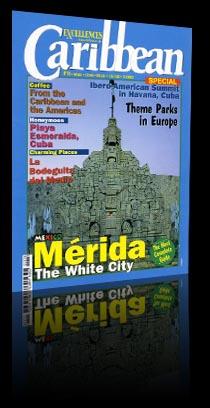Merida, The White City
To travel to Merida (Yucatan) from Palenque where my trip began the options were not many. We set out very early on our "Suburban" Chevrolet for Villahermosa airport where we will take Merida plane. However, an unforeseeable event imbued with emotion the second part of my trip to Mexico.
A problem in the car caused that I arrived at the hotel 30 minutes later and on top of that, when leaving Palenque, we had to stop on a bridge, this made everybody very nervous, but our driver Roberto proved to be an expert. We drove the 150 km that separated Palenque from Villahermosa in a record time. Fifteen minutes before the flight was closed, I was in the Aerocaribbean sales windows with my landing pass, ready to travel to Merida airport. I was happy again for the second part of my first trip to Mexico as the first one to Chiapas (Excellences Nº. 15) started very well. Even before arriving to Merida city, there was a new and pleasant surprise, the commander of the plane announced that we will land in the City of Carmen to refuel. From the air, the City of Carmen offered a pleasant view. It is a coastal village with beautiful beaches and a nice urban road arrangement. The beach of the village was similar to a postcard with fishermen's boats on the sand and the networks all around.
In Merida The first impression when arriving at Merida was a brilliant light, a joyful atmosphere and a different and strong warm weather from that of Chiapas. This makes my spirit feel happy, I visited the main avenues that showed a cosmopolitan and intense traffic. Paseo Montejo (Montejo Ride) in a certain way was similar to Elysian Fields, before having lunch at the El Guacamayo Restaurant, I enjoyed a short walk by the City Hall, the Cathedral and the brand-new Cultural Center, all the tour was made under the light of a sort of a sun unknown to me. Then after lunch, a heavy rain fell, the intensity was also new to me, despite the fact that I have visited before the Caribbean twenty times. The night fell, hurricane-like winds blew and what was blue became black. This is an example of how unforeseeable can be the Caribbean in Merida. The new day seemed to be something passionate, the first thing we did was to visit a fruit and vegetable market, an unforgettable experience since everything was interesting to me: the local fruits, vendors and posters of the famous funny artist "Chupacabras" with Mexican girls bursting of laughter. Then we set out for Dzibilchaltum, an archeological area, located just 22 km from Merida, one of the oldest Maya area located on the north. The term means "a place where a scripture appears written on a stone". The site was inhabited since the year 500 B.C. until the Sapniards' arrival. According to hundred vestiges found in the area of Dzibilchaltum, this seaside place used to have 40,000 inhabitants during a flourishing time and had an intense trade with salt and fish. Its main water supply was the small lake by the Palace, I could not helped it and swam there. Along with the main temples of this magnificent archeological area, I discovered the mythical plant of anaquel. This plant has been for a time the best treasure of Merida city, even in the last century was the State way of exchange, i.e. the currency. Anaquel plantations filled the vast plains and were one of the significant items of the country. An important industry was developed around this plant from which the best rope of the world was made.
Progreso and the Sea The sea is rather far from Merida city so we decided to leave the visit to Progreso until dawn on the next day. We set out for the sea in the morning at 5:00 a.m. heading to the sea, to weak up early worthed the effort, what I saw was a truly palette of light and color, one of the most beautiful dawns I ever lived. The salt pits formed like a moon landscape, populated by black birds and the horizon was pure fire, once the sun rose we continue our way to Progreso, the summer village of Merida citizens, a long and clean beach, a commercial port, and something that never fails, a line of chiringuitos with their typical posters announcing everything: shrimps, paellas, antojitos, rice and tequila.
HACIENDAS This beautiful coastal village had a strange charm, the harmony of its street, the smell of a clean sea and the quite atmosphere made difficult the departure, but we had to visit one of the largest haciendas in Merida, that of San Antonio Cucul. With the courteous assistance of the landlady of the Hacienda, we discovered the best corners of the place, the hideout of iguanas, we visited the area where tools were put away to elaborate sisal and the small chapel as well. The place was like a dream and was used as such, as a way to compensate for the maintenance costs. The landlady of the Hacienda rented the place by hours, days or weeks to celebrate the fifteen anniversary of a girl, weddings or for holding congresses. This is a way of dreaming that one can be the owner for a limited period of time of such a place. After the usual farewell, I did not have much time, the trip to Merida city was getting over, short, but intense. Then what remained was the traveler's routine: go to the hotel, pick up the luggage and restore my energies in a cafeteria and get the bus heading to Campeche state, another route and the third part of my first trip to Mexico.






























































